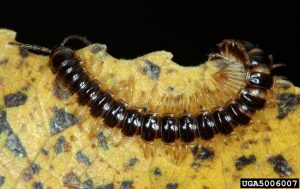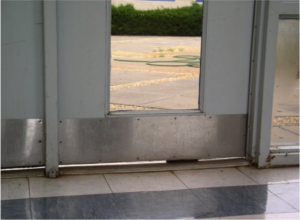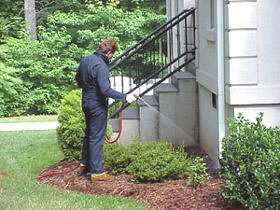Millipedes are common occasional pests that sometimes invade buildings, particularly during very hot, dry weather, or after heavy rainfall. Millipedes do not bite, sting, or transmit diseases, nor do they infest food, clothing or dry, structurally sound wood. Therefore, they are considered more of a nuisance pest, although they can give off an unpleasant odor.

Photo: David Cappaert, Bugwood.org
Millipedes vary in both color and size. The species that most commonly invades buildings is referred to as the “garden millipede,” which is brownish-black in color and about an inch long (see photo at right). When disturbed, millipedes often curl up into a “C” shape and remain motionless. Some people confuse millipedes with centipedes, which look somewhat similar. However, centipedes have only one pair of legs per body segment, while millipedes have two pair of legs per body segment. Centipedes also tend to move about more quickly than millipedes.
Millipedes pass the winter primarily as adults and lay their eggs in the soil in the spring. Individuals may live for several years. Millipedes are attracted to dark, cool, moist environments that are rich in organic matter, such as compost piles, heavily mulched areas, rotting logs, or the soil under logs and stones. They usually go unnoticed because they live in these relatively hidden habitats. Millipedes are scavengers, feeding primarily on decomposing vegetation, but occasionally they will damage soft-stemmed plants in gardens.
Major nuisance problems usually occur when the conditions become too hot and dry and the millipedes move to find moisture, or else when it’s too wet and water-saturated soils force them to the surface and higher ground where they often end up on concrete slabs, foundations and siding. Millipedes may also migrate in the fall, presumably in search of overwintering sites. All of these activities result in millipedes invading crawl spaces, basements, and other areas of buildings. Common points of entry include door thresholds (especially at the base of sliding glass doors, garage doors, etc.), expansion joints, and through the voids of concrete block walls. Frequent indoor sightings of these pests usually means that there are large numbers breeding outdoors in the lawn, or beneath mulch, leaf litter or debris close to the foundation. Millipedes do not survive indoors for more than a few days (more likely just a few hours) unless they can find suitable moist conditions.
Managing Millipedes
Emphasis should be placed on reducing conditions and access points favorable to millipede invasions:
Minimize Moisture, Remove Debris – the most effective, long-term measure for reducing entry of millipedes (and many other pests) is to reduce excess moisture and hiding places, especially near the foundation:
 Remove leaves, grass clippings, heavy accumulations of mulch, wooden boards, stones, boxes, and similar items laying on the ground beside the foundation. This does not mean you can’t have mulch around the foundation; simply keep it 6-12″ away from the wall. Consider using an inorganic mulch, such as gravel, which will drain better (see photo at right).
Remove leaves, grass clippings, heavy accumulations of mulch, wooden boards, stones, boxes, and similar items laying on the ground beside the foundation. This does not mean you can’t have mulch around the foundation; simply keep it 6-12″ away from the wall. Consider using an inorganic mulch, such as gravel, which will drain better (see photo at right).
Prevent water from accumulating near the foundation, in basement walls or in the crawl space. Keep gutters and down spouts free of debris and use either splash guards or perforated pipe to reduce puddling. Homes with poor drainage may need to have foundation drains installed, or the surrounding ground contoured or sloped to redirect surface water away from the foundation.
Repair leaking exterior water spigots and prevent water from puddling where there are drip lines from air conditioning units. Reduce the humidity in crawl spaces and basements by providing adequate ventilation, sump pumps, polyethylene soil covers, dehumidifiers, etc.
Since millipedes thrive in the moist, dense thatch layer of poorly maintained turf. De-thatching the lawn and keeping the grass mowed should make the lawn less suitable for millipedes. Over-watering may also contribute to millipede problems.
 Install door sweeps on all exterior entry doors, and apply caulk along the bottom outside edge and sides of door thresholds (see photo at right).
Install door sweeps on all exterior entry doors, and apply caulk along the bottom outside edge and sides of door thresholds (see photo at right).Chemical control
Application of insecticides along baseboards and other interior living areas of the home do not really stop millipede invasions. Once indoors, millipedes end up in kitchens, living rooms, etc., and soon die from a lack of moisture. Remove them with a vacuum cleaner or broom.
 Applications of insecticide outdoors may help to reduce inward invasion of millipedes and other pests. Treat along entryways, around crawl space doors, foundation vents and utility openings, and up underneath siding. Perimeter sprays (shown at left) may also help but are rarely 100% effective in stopping the millipedes. Pesticides labeled for outdoor use around homes, such as products made by Bayer, Ortho, and Spectracide may be purchased from local hardware stores. The key to successful chemical control is spray volume; i.e., that amount of diluted chemical that you apply over an area. The spray must penetrate the soil, not simply lightly coat the surface. The best means of application for homeowners is a garden hose attachment. Treat a 2-5 foot wide area of ground along the foundation in mulched, ornamental plant beds and grassy areas, as well as an 18-24 inch wide vertical band of the foundation wall.
Applications of insecticide outdoors may help to reduce inward invasion of millipedes and other pests. Treat along entryways, around crawl space doors, foundation vents and utility openings, and up underneath siding. Perimeter sprays (shown at left) may also help but are rarely 100% effective in stopping the millipedes. Pesticides labeled for outdoor use around homes, such as products made by Bayer, Ortho, and Spectracide may be purchased from local hardware stores. The key to successful chemical control is spray volume; i.e., that amount of diluted chemical that you apply over an area. The spray must penetrate the soil, not simply lightly coat the surface. The best means of application for homeowners is a garden hose attachment. Treat a 2-5 foot wide area of ground along the foundation in mulched, ornamental plant beds and grassy areas, as well as an 18-24 inch wide vertical band of the foundation wall.
When treating outdoor areas, remember these important points
Spraying mulch is ineffective because the chemical can bind to the mulch and not penetrate to the soil. Heavy accumulations of mulch and leaf litter should be raked back from the foundation first to expose millipede hiding areas and allow the pesticide to penetrate the soil more readily.
Keep children and pets away from treated areas until the chemical dries (or longer if specified on the product label).
Watch out for pesticide drifting and contaminating toys, swimming pools, and other objects, such as grills.
Pest information and control recommendations presented here were developed for North Carolina and may not be appropriate for other states or regions. Any recommendations for the use of chemicals are included solely as a convenience to the reader and do not imply that insecticides are necessarily the sole or most appropriate method of control. Any mention of brand names or listing of commercial products or services in the publication does not imply endorsements by North Carolina Cooperative Extension nor discrimination against similar products or services. All recommendations for pesticide use were legal at the time of publication, but the status of pesticide registrations and use patterns are subject to change by actions of state and federal regulatory agencies. Individuals who use chemicals are responsible for using these products according to the regulations in their state and to the guidelines on the product label. Before applying any chemical, always obtain current information about its use and read the product label carefully. For assistance, contact the Cooperative Extension Center in your county.
Distributed in furtherance of the acts of Congress of May 8 and June 30, 1914. North Carolina State University and North Carolina A&T State University commit themselves to positive action to secure equal opportunity regardless of race, color, creed, national origin, religion, sex, age, or disability. In addition, the two Universities welcome all persons without regard to sexual orientation. North Carolina State University, North Carolina A&T State University, U.S. Department of Agriculture, and local governments cooperating.

